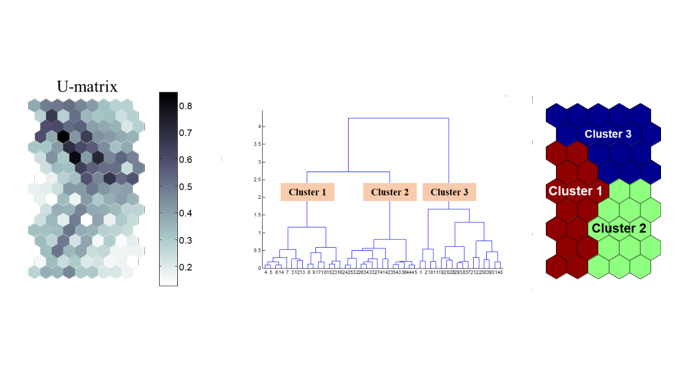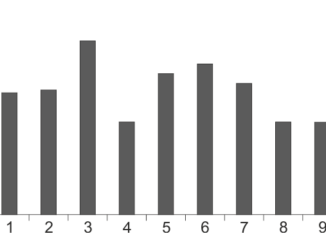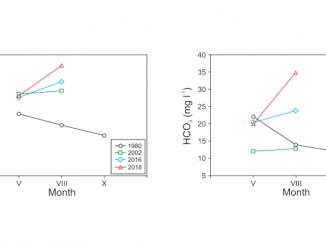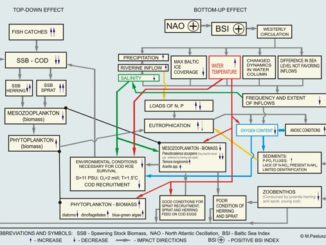
Paper category: Original research paper
Corresponding author: Jong-Yun Choi (jyc311@naver.com)
DOI: 10.1515/ohs-2020-0029
Received: 29/04/2020
Accepted: 23/06/2020
Full text: here
Citation (APA style): Kim, S., Kim, J., Joo, G., & Choi, J. (2020). Response of the rotifer community to human-induced changes in the trophic state of a reservoir, Oceanological and Hydrobiological Studies, 49(4), 329-344. doi: https://doi.org/10.1515/ohs-2020-0029
Abstract
Human disturbance and nutrient runoff lead to water pollution, particularly in downstream waters and reservoirs. We hypothesized that increased human activity in summer would affect the trophic state of downstream reservoirs, affecting the interannual species composition of rotifers. We used long-term data for the Unmun Reservoir in South Korea (2009–2015), which is increasingly affected by human activity. The interannual variation of nitrogen and phosphorus levels was higher in summer and autumn, resulting in eutrophication. This led to a change in species composition of rotifers. Anuraeopsis fissa, Brachionus calyciflorus and Trichocerca gracilis were abundant in the most eutrophic state, while high densities of Ascomorpha ovalis and Ploesoma hudsoni were observed when nutrient concentrations were lower. The trophic state changes in the Unmun Reservoir were largely attributed to summer human activity in tributary streams. Our study location is typical of the stream network in South Korea and we assume that similar trophic state changes in reservoirs will be common. Changes in the density and species diversity of rotifers due to eutrophication indicate the need for active management and conservation, including the restriction of human activity around streams.
Acknowledgements
This research was supported by the Basic Science Research Program through the National Research Foundation of Korea (NRF) funded by the Ministry of Education (grant No. NRF-2012-R1A6A3A04040793).
References
Allan, J.D. (1976). Life history patterns in zooplankton. Am. Nat. 110(971): 165–180. DOI: 10.1086/283056.
Alvani, J., Boustani, F., Tabiee, O. & Hashemi, M. (2011). The effects of human activity in Yasuj Area on the health of Stream city. Int. J. Soc. Behav. Educ. Econ. Bus. Ind. Eng. 50: 341–345.
Angelidis, M.O., Markantonatos, P.G. & Bacalis N.C. (1995). Impact of human activities on the quality of river water: the case of Evrotas River catchment basin, Greece. Environ. Monit. Assess. 35(2): 137–153. DOI: 10.1007/BF00633711.
Arndt, H. (1993). Rotifers as predators on components of the microbial web (bacteria, heterotrophic flagellates, ciliates) – a review. In J.J. Gilbert, E. Lubzens & M.R. Miracle (Eds.), Rotifer Symposium VI (pp. 231–246). Dordrecht: Springer.
Balvay, G. & Laurent, M. (1990). Long-term quantitative evolution of rotifers during the eutrophication in Lake Geneva. Aquat. Sci. 52(2): 162–175.
Balvay, G. (1989). Evolution of rotifer biocenosis during changes of the trophic state in Lake Geneva and comparison with Lake Constance. Rev. Des Sci. De L'Eau/J. Water Sci. 2(4): 739–753.
Bays, J.S. & Crisman, T.L. (1983). Zooplankton and trophic state relationships in Florida lakes. Can. J. Fish. Aquat. Sci. 40(10): 1813–1819. DOI: 10.1139/f83-210.
Beaver, J.R. & Crisman, T.L. (1990). Use of microzooplankton as an early indicator of advancing cultural eutrophication. Verh. Internat. Verein. Theor. Angew. Limnol. 24(1): 532–537. DOI: 10.1080/03680770.1989.11898794.
Bogdan, K.G., Gilbert, J.J. & Starkweather, P.L. (1980). In situ clearance rates of planktonic rotifers. In H.J. Dumont & J. Green (Eds.), Rotatoria (pp. 73–77). Dordrecht: Springer.
Boo, K.O., Kwon, W.T. & Baek, H.J. (2006). Change of extreme events of temperature and precipitation over Korea using regional projection of future climate change. Geophys. Res. Lett. 33(1). DOI: 10.1029/2005GL023378.
Buikema, Jr A.L., Cairns, J. & Sullivan, G.W. (1974). Rotifers as monitors of heavy metal pollution in water. Bulletins, Virginia Water Resources Research Center.
Castro, B.B., Antunes, S.C., Pereira, R., Soares, A.M. & Goncalves, F. (2005). Rotifer community structure in three shallow lakes: seasonal fluctuations and explanatory factors. Hydrobiologia 543(1): 221–232. DOI: 10.1007/s10750-004-7453-8.
Cèrèghino, R. & Park, Y.S. (2009). Review of the self-organizing map (SOM) approach in water resources: commentary. Environ. Model. Softw. 24: 945–947. DOI: 10.1016/j.envsoft.2009.01.008.
Chae, B.S. & Yang, H.J. (1999). Microphysogobio rapidus, a new species of gudgeon (Cyprinidae, Pisces) from Korea, with revised key to species of the genus Microphysogobio of Korea. Korean J. Biol. Sci. 3(1): 17–21.
Chen, X., Zhang, Z.C., Chen, X.H. & Shi, P. (2009). The impact of land use and land cover changes on soil moisture and hydraulic conductivity along the karst hillslopes of southwest China. Environ. Earth Sci. 59(4): 811–820. DOI: 10.1007/s12665-009-0077-6.
Chon, T.S., Park, Y.S., Moon, K.H. & Cha, E.Y. (1996). Patternizing communities by using an artificial neural network. Ecol. Modell. 90: 69–78. DOI: 10.1016/0304-3800(95)00148-4.
Dejen, E., Vijverberg, J., Nagelkerke, L.A. & Sibbing, F.A. (2004). Temporal and spatial distribution of microcrustacean zooplankton in relation to turbidity and other environmental factors in a large tropical lake (L. Tana, Ethiopia). Hydrobiologia 513(1–3): 39–49. DOI: 10.1023/B:hydr.0000018163.60503.b8.
Devetter, M. (1998). Influence of environmental factors on the rotifer assemblage in an artificial lake. Hydrobiologia 387: 171–178. DOI: 10.1023/A:1017050011995.
Duggan, I.C., Green, J.D. & Shiel, R.J. (2001). Distribution of rotifers in North Island, New Zealand, and their potential use as bioindicators of lake trophic state. In L. Sanoamuang, H. Segers, R.J. Shiel & R.D. Gulati (Eds.), Rotifera IX (pp. 155–164.). Dordrecht: Springer.
Duggan, I.C., Green, J.D. & Shiel, R.J. (2002). Distribution of rotifer assemblages in North Island, New Zealand, lakes: relationships to environmental and historical factors. Freshw. Biol. 47(2): 195–206. DOI: 10.1046/j.1365-2427.2002.00742.x.
Edmondson, W.T. (1965). Reproductive rate of planktonic rotifers as related to food and temperature in nature. Ecol. Monogr. 35(1): 61–111. DOI: 10.2307/1942218.
Elliott, J.I. (1977). Seasonal changes in the abundance and distribution of planktonic rotifers in Grasmere (English Lake District). Freshw. Biol. 7(2): 147–166. DOI: 10.1111/j.1365-2427.1977.tb01665.x.
Erdoğan, S. & Güher, H. (2005). The Rotifera fauna of Gala Lake (Edirne-Turkey). Pak. J. Biol. Sci. 8(11): 1579–1583.
Fielding, A.H. (1999). An introduction to machine learning methods. In A. Fielding (Ed.), Machine learning methods for ecological applications. Massachusetts, Kluewer Academic Publishers.
Frost, T.M., Carpenter, S.R. & Kratz, T.K. (1992). Choosing ecological indicators: effects of taxonomic aggregation on sensitivity to stress and natural variability. In D.H. McKenzie, D.E. Hyatt & V.J. McDonald (Eds.), Ecological indicators (pp. 215–227). Boston, MA, Springer.
Gannon, J.E. & Stemberger, R.S. (1978). Zooplankton (especially crustaceans and rotifers) as indicators of water quality. Trans. Am. Microsc. Soc. 97(1): 16–35. DOI: 10.2307/3225681.
Gao, H.D., Zhang, S.S., Zhao, R.F. & Zhu, L.C. (2018). Plankton community structure analysis and water quality bioassessment in Jiulong Lake. IOP Conf. Ser. Earth Environ. Sci. 199(2): 022031. DOI: 10.1088/1755-1315/199/2/022031.
Gao, Y., Lai, Z.N., Wang, G.J., Liu, Q.F. & Yu, E.M. (2019). Distribution of Zooplankton Population in Different Culture Ponds from South China. Nat. Environ. Pollut. Technol. 18(1): 81–88.
Gasol, J.M., Simons, A.M. & Kalff, J. (1995). Patterns in the top-down versus bottom-up regulation of heterotrophic nanoflagellates in temperate lakes. J. Plankton Res. 17(10): 1879–1903. DOI: 10.1093/plankt/17.10.1879.
Gilbert, J.J. & Bogdan, K.G. (1981). Selectivity of Polyarthra and Keratella for flagellate and aflagellate cells. Verh. Internat. Verein. Theor. Angew. Limnol. 21(3): 1515–1521. DOI: 10.1080/03680770.1980.11897224.
Giraudel, J.L. & Lek, S. (2001). A comparison of self-organizing map algorithm and some conventional statistical methods for ecological community ordination. Ecol. Modell. 146: 329–339. DOI: 10.1016/S0304-3800(01)00324-6.
Goethals, P. & De Pauw, N. (2001). Development of a concept for integrated ecological river assessment in Flanders, Belgium. J. Limnol. 60(1s): 7–16.
Grady, S.J. & Mullaney, J.R. (1998). Natural and human factors affecting shallow water quality in surficial aquifers in the Connecticut, Housatonic, and Thames River Basins Vol. 4. US Department of the Interior, US geological Survey.
Grau, H.R., Aide, T.M., Zimmerman, J.K., Thomlinson, J.R., Helmer, E. et al. (2003). The ecological consequences of socioeconomic and land-use changes in postagriculture Puerto Rico. BioScience 53(12): 1159–1168. DOI: 10.1641/0006-3568(2003)053[1159:TECOSA]2.0.CO;2.
Große, W. (1996). Pressurised ventilation in floating-leaved aquatic macrophytes. Aquat. Bot. 54(2–3): 137–150. DOI: 10.1016/0304-3770(96)01041-8.
Gupta, N., Pandey, P. & Hussain, J. (2017). Effect of physicochemical and biological parameters on the quality of river water of Narmada, Madhya Pradesh, India. Water Sci. 31(1): 11–23. DOI: 10.1016/j.wsj.2017.03.002.
Haney, J.F. & Hall, D.J. (1973). Sugar‐coated Daphnia: A preservation technique for Cladocera 1. Limnol. Oceanogr. 18(2): 331–333. DOI: 10.4319/lo.1973.18.2.0331.
Hessen, D.O. & Nilssen, J.P. (1985). Factors controlling rotifer abundances in a norwegian eutrophic lake: an experimental study. Ann. Limnol. Int. J. Limnol. 21(2): 97–105. DOI: 10.1051/limn/1985017.
Jackson, L.E., Kurtz, J.C. & Fisher, W.S. (2000). Evaluation guidelines for ecological indicators. NC, US Environmental Protection Agency, Office of Research and Development.
Jafari, N., Nabavi, M.S. & Akhavan, M. (2011). Ecological investigation of zooplankton abundance in the river Haraz, Northeast Iran: impact of environmental variables. Arch. Biol. Sci. 63(3): 785–798. DOI: 10.2298/ABS1103785J.
Kang, E.J., Yang, H., Lee, H.H., Cho, Y.C., Kim, E.O. et al. (2007). Ecology and early life history of endangered freshwater fish, Pseudobagrus brevicorpus (Pisces: Bagridae). Korean J. Environ. Biol. 25(4): 378–384.
King, J.G. & Mace, Jr A.C. (1974). Effects of recreation on water quality. J. Water Pollut. Control Fed. 46: 2453–2459.
Kohonen, T. (1982). Self-organized formation of topologically correct feature maps. Biol. Cybern. 43: 59–69. DOI: 10.1007/BF00337288.
Kohonen, T. (1997). Self-organizing Maps. New York, Springer.
Koste, W. (1978). Rotatoria: die Rädertiere Mitteleuropas (2rd ed). Berlin and Stuttgart, Gebruder Borntraeger.
Kuczynski, D. (1987). The rotifer fauna of Argentine Patagonia as a potential limnological indicator. Hydrobiologia 150(1): 3–10. DOI: 10.1007/BF00006605.
Larsson, P. & Lampert, W. (2011). Experimental evidence of a low‐oxygen refuge for large zooplankton. Limnol. Oceanogr. 56(5): 1682–1688. DOI: 10.4319/lo.2011.56.5.1682.
Lee, J.Y., Choi, Y.K., Kim, H.S. & Yun, S.T. (2005). Hydrologic characteristics of a large rockfill dam: Implications for water leakage. Eng. Geol. 80(1–2): 43–59. DOI: 10.1016/j.enggeo.2005.03.002.
Mäemets, A. (1983). Rotifers as indicators of lake types in Estonia. Hydrobiologia 104(1): 357–361. DOI: 10.1007/BF00045991.
Mizuno, T. & Takahashi, E. (1999). An illustration guide to freshwater zooplankton in Japan. Simizu: Tokai University.
Nandini, S., Ramírez-García, P. & Sarma, S.S.S. (2005). Seasonal variations in the species diversity of planktonic rotifers in Lake Xochimilco, Mexico. J. Freshw. Ecol. 20(2): 287–294. DOI: 10.1080/02705060.2005.9664968.
Odum, H.T. (1994). Ecological and general systems: An introduction to systems ecology. Colorado University Press, USA.
Ogbeibu, A.E. & Oribhabor, B.J. (2002). Ecological impact of river impoundment using benthic macro-invertebrates as indicators. Water Res. 36(10): 2427–2436. DOI: 10.1016/S0043-1354(01)00489-4.
Oh, H.J., Jeong, H.G., Nam, G.S., Oda, Y., Dai, W. et al. (2017). Comparison of taxon-based and trophi-based response patterns of rotifer community to water quality: applicability of the rotifer functional group as an indicator of water quality. Anim. Cells Syst. 21(2): 133–140. DOI: 10.1080/19768354.2017.1292952.
Olajire, A.A. & Imeokparia, F.E. (2001). Water quality assessment of Osun River: studies on inorganic nutrients. Environ. Monit. Assess. 69(1): 17–28. DOI: 10.1023/A:1010796410829.
Ooms-Wilms, A.L. (1991). Ingestion of fluorescently labelled bacteria by rotifers and cladocerans in Lake Loosdrecht as measures of bacterivory: preliminary results. Mem. Ist. ital. Idrobiol. 48: 269–278.
Pace, M.L. (1986). An empirical analysis of zooplankton community size structure across lake trophic gradients 1. Limnol. Oceanogr. 31(1): 45–55. DOI: 10.4319/lo.1986.31.1.0045.
Pappas, E.A., Smith, D.R., Huang, C., Shuster, W.D. & Bonta, J.V. (2008). Impervious surface impacts to runoff and sediment discharge under laboratory rainfall simulation. Catena 72(1): 146–152. DOI: 10.1016/j.catena.2007.05.001.
Pourriot, R. (1997). Food and feeding habits of rotifera. Arch. Hydrobiol. Ergebn. Limnol. 8: 243–260.
Singh, U.B., Ahluwalia, A.S., Sharma, C., Jindal, R. & Thakur, R.K. (2013). Planktonic indicators: a promising tool for monitoring water quality (early-warning signals). Ecol. Environ. Conserv. 19(3): 793–800.
Sládeček, V. (1983). Rotifers as indicators of water quality. Hydrobiologia 100(1): 169–201. DOI: 10.1007/BF00027429.
Snell, T.W., Moffat, B.D., Janssen, C. & Persoone, G. (1991). Acute toxicity tests using rotifers. III. Effects of temperature, strain, and exposure time on the sensitivity of Brachionus plicatilis. Environ. Toxicol. Water Qual. 6(1): 63–75. DOI: 10.1002/tox.2530060106.
Snyder, P.K., Delire, C. & Foley, J.A. (2004). Evaluating the influence of different vegetation biomes on the global climate. Clim. Dyn. 23(3–4): 279–302. DOI: 10.1007/s00382-004-0430-0.
Søndergaard, M. & Jeppesen, E. (2007). Anthropogenic impacts on lake and stream ecosystems, and approaches to restoration. J. Appl. Ecol. 44(6): 1089–1094. DOI: 10.1111/j.1365-2664.2007.01426.x.
Suthar, S., Sharma, J., Chabukdhara, M. & Nema, A.K. (2010). Water quality assessment of river Hindon at Ghaziabad, India: impact of industrial and urban wastewater. Environ. Monit. Assess. 165(1–4): 103–112. DOI: 10.1007/s10661-009-0930-9.
Uriarte, E.A. & Martín, F.D. (2005). Topology preservation in SOM. Int. J. Appl. Math. Comput. Sci. 1(1): 19–22.
Vesanto, J. & Alhoniemi, E. (2000). Clustering of the self-organizing map. IEEE Trans. Neural Netw. 11: 586–600. DOI: 10.1109/72.846731.
Walz, N. (1995). Rotifer populations in plankton communities: energetics and life history strategies. Experientia 51(5): 437–453. DOI: 10.1007/BF02143197.
Wang, S.B., Xie, P. & Geng, H. (2010). The relative importance of physicochemical factors and crustacean zooplankton as determinants of rotifer density and species distribution in lakes adjacent to the Yangtze River, China. Limnologica 40(1): 1–7. DOI: 10.1016/j.limno.2009.03.001.
Watson, F., Vertessy, R., McMahon, T., Rhodes, B. & Watson, I. (2001). Improved methods to assess water yield changes from paired-catchment studies: application to the Maroondah catchments. For. Ecol. Manage. 143(1–3): 189–204. DOI: 10.1016/S0378-1127(00)00517-X.
Wetzel, R.G. & Likens, G.E. (2000). Limnological Analyses. NY, Springer-Verlag.
Xi, Y.L., Dong, L.L., Ge, Y.L. & Liu, G.Y. (2004). Resting egg production of Brachionus calyciflorus (Rotifera) at different water temperatures. J. Freshw. Ecol. 19(4): 567–573. DOI: 10.1080/02705060.2004.9664736.
Yang, X., Ren, L., Singh, V.P., Liu, X., Yuan, F. et al. (2012). Impacts of land use and land cover changes on evapotranspiration and runoff at Shalamulun River watershed, China. Hydrol. Res. 43(1–2): 23–37. DOI: 10.2166/nh.2011.120.
Yin, L., Ji, Y., Zhang, Y., Chong, L. & Chen, L. (2018). Rotifer community structure and its response to environmental factors in the Backshore Wetland of Expo Garden, Shanghai. Aquac. Fish. 3(2): 90–97. DOI: 10.1016/j.aaf.2017.11.001.
Yoshida, T., Urabe, J. & Elser, J.J. (2003). Assessment of ‘top-down’and ‘bottom-up’forces as determinants of rotifer distribution among lakes in Ontario, Canada. Ecol. Res. 18(6): 639–650. DOI: 10.1111/j.1440-1703.2003.00596.x




Bądź pierwszy, który skomentuje ten wpis